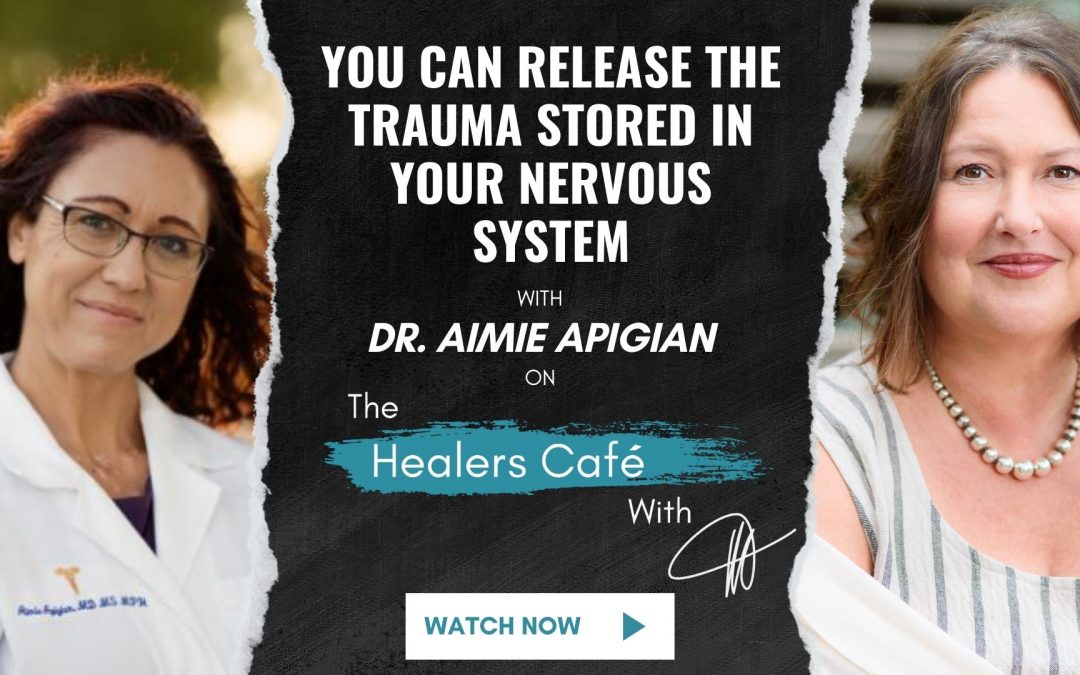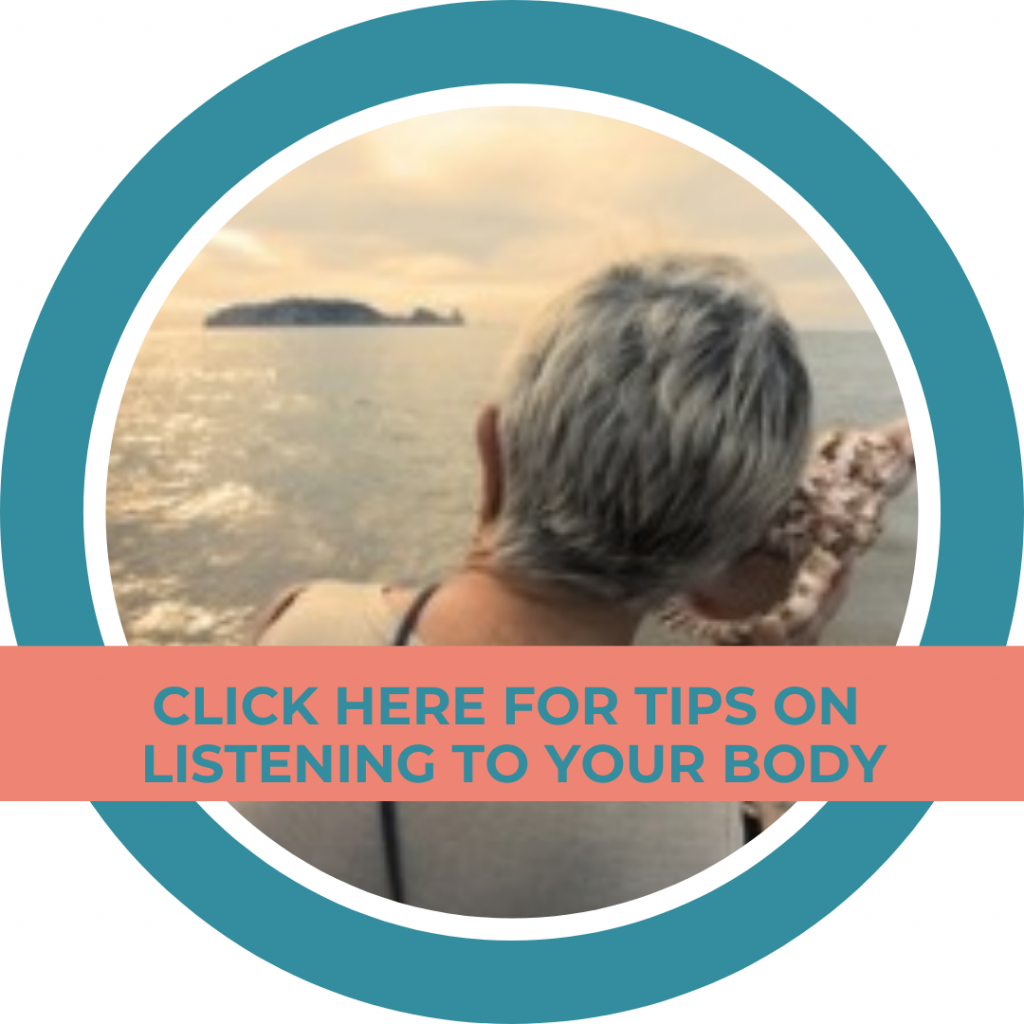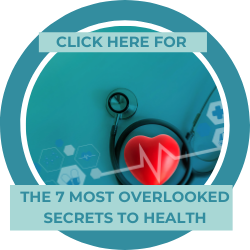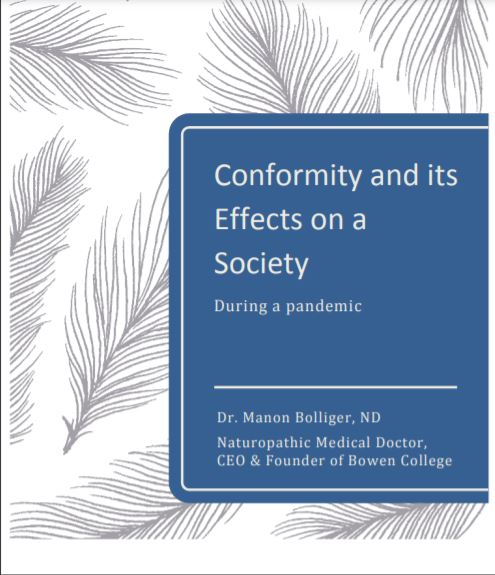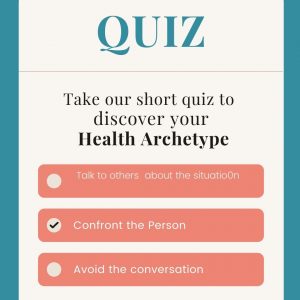You Can Release the Trauma Stored in Your Nervous System – Dr. Aimie Apigian on The Healers Café with Manon Bolliger
In this episode of The Healers Café, Manon Bolliger (facilitator and retired naturopath with 30+ years of practice) speaks with Dr. Aimie Apigian about how our bodies store trauma in the nervous system and how to release it.
Highlights from today’s episode include:
Dr. Aimie Apigian
The trauma response is communicated through a different branch of our nervous system. It’s not going to be communicated to the sympathetic chain. That is only the stress response. It only knows how to turn on the stress response and to initiate adrenaline. The trauma response then, is initiated by two triggers when that stress response has been activated.
Dr. Aimie Apigian
Those are the two triggers, that our body will say, Hmm, we actually, we’re not big enough for this, we’re not strong enough for this, we’re not smart enough for this, we’re not fill in the blank enough for this. And our better strategy, better strategy for surviving this moment in time is actually to shut down.
– – – – –
Dr. Aimie Apigian
And so, trauma is an energy problem. And it causes energy problems, it causes damage to our mitochondria starts to build up oxidative stress, not only outside of ourselves, but inside of ourselves. And just by the fact that the body is in the trauma response, it also shuts down our detoxification system.
ABOUT DR AIMIE APIGIAN:
Dr. Aimie Apigian, MD, MS, MPH is the leading medical expert on how life experiences get stored in the body and restoring the body to its best state of health through her signature model and methodology, The Biology of Trauma™. She is a double board-certified medical physician in Preventive Medicine and Addiction Medicine. She has a Masters in Biochemistry and a Masters in Public Health. In addition to her medical training, she is also a Certified Functional Medicine physician and has training and certifications specifically in neuro-autoimmunity, nutrition, and genetics for addictions, mental health, and mood and behavioral disorders. She has several certifications in various trauma therapies including the Instinctual Trauma Response Model an art trauma therapy, Somatic Experiencing & developed by Dr. Peter Levine, and NeuroAffective Touch & Dr. Aline LaPierre.
Dr. Aimie brings you The Biology of Trauma™: a new lens and a methodology that courageously both adds to and bridges trauma work and medicine by reverse-engineering the chronic effects of trauma on the nervous system and body on a cellular level.
Dr. Aimie’s personal life experiences lead her into trauma therapy training, first for her adopted son, and then for herself. A unique lens for understanding trauma has come out of it, joining the two worlds of neuroscience and trauma therapy uniquely. It became the thread that ties it all together in a way that clinicians and patients find understandable and easily applied within their daily life.
Dr. Aimie offers science-based solutions on how to rewire the nervous system with The Biology of Trauma. Accelerating the healing journey through recovery to resilience, presence, and aliveness. Dr. Aimie is the founder and CEO of Trauma Healing Accelerated, offering her foundational online course: “The 21 Day Journey to Calm Aliveness”, which is an experiential journey into the nervous system that is open to all as well as her 8 module certification course for practitioners, “Biology of Trauma” that teaches the protocols of addressing The Biology of Trauma on the different systems of the body.
Core purpose/passion: Fueled by how my life has been affected by attachment trauma starting with my father and then my son and then needing to address my own insecure attachment patterns, my mission is to share what I have learned to accelerate the healing journey of attachment trauma of others. Understanding attachment, trauma and the nervous system is just the beginning, and science and the experience of others are now confirming that even the most difficult of situations can improve without requiring years of therapy.
Website | Facebook | Instagram | LinkedIn | YouTube | Freebie : Steps to Identify and Heal Trauma – A Roadmap for Healing:
About Manon Bolliger
As a recently De-Registered board-certified naturopathic physician & in practice since 1992, I’ve seen an average of 150 patients per week and have helped people ranging from rural farmers in Nova Scotia to stressed out CEOs in Toronto to tri-athletes here in Vancouver.
My resolve to educate, empower and engage people to take charge of their own health is evident in my best-selling books: ‘What Patients Don’t Say if Doctors Don’t Ask: The Mindful Patient-Doctor Relationship’ and ‘A Healer in Every Household: Simple Solutions for Stress’. I also teach BowenFirst™ Therapy through Bowen College and hold transformational workshops to achieve these goals.
So, when I share with you that LISTENING to Your body is a game changer in the healing process, I am speaking from expertise and direct experience”.
Mission: A Healer in Every Household!
For more great information to go to her weekly blog: http://bowencollege.com/blog.
For tips on health & healing go to: https://www.drmanonbolliger.com/tips
SOCIAL MEDIA:
– Linktr.ee | Rumble | Gettr | Facebook | Instagram | LinkedIn | YouTube | Twitter |
About The Healers Café:
Manon’s show is the #1 show for medical practitioners and holistic healers to have heart to heart conversations about their day to day lives.
Follow us on social media! https://www.facebook.com/thehealerscafe
TRANSCRIPT
Welcome to the Healers Café. Conversations on health and healing with Manon Bolliger. A retired and deregistered naturopathic physician with 30 plus years of experience. Here, you will discover engaging and informative conversations between experienced healers, covering all aspects of healing, the personal journey, the journey of the practitioner, and the amazing possibilities for our own body, and spirit.
Manon Bolliger 00:13
Welcome to the Healers Café. And today I have with me Dr. Aimee, I did check your name pronounces. Is it Apigay?
Dr. Aimie Apigian 00:23
Apigian.
Manon Bolliger 00:24
Apigian. Okay. And she’s an MD and M P H and is the leading medical expert on how life experiences get stored in the body and restoring the body to its best state of health through her signature model and methodology called the biology of trauma. She’s a double board-certified medical physician in preventative medicine and in addiction medicine. And she has a master’s in biochemistry and a master’s in public health. In addition to her medical training, she’s also a certified functional medicine physician, and has training and certifications specifically in neuro auto immunity, nutrition and genetics for addiction, mental health and mood and behavioral disorders. And she has several certifications in various trauma therapies, including the instinctual trauma response model, and art trauma therapy, somatic experiencing and…but that was developed by Dr. Peter Levine and neuro effective touch by Dr. Eileen Napier. So, wow, that certainly you’ve covered every aspect that one would need to know to really serve your client at the highest degree because you’ve got choices, tons of choices. So could you tell me a little bit how did all this start? Why did you go into this? What brought you this way?
Dr. Aimie Apigian 02:07
Yeah, my story with traumas specifically started when I was in medical school, I had actually just finished my master’s in biochemistry, and had a few months free before I jumped back into the third year of medical school rotations. And I decided to use that time to become a foster parent. And it was not until I had restarted the medical school rotations that they actually found a placement. And so they called me and they explained that they had four year old Miguel and gave me a brief history. And that’s how he came into my life, my home my hearts. And I thought I knew what he needed. I thought he needed, of course, love and stability and time and that he would be fine. That’s also what the social workers told me. And I had a lot to learn. And it was certainly one of the hardest experiences I’ve been through. And very grateful for it now because it made me…well and I chose to write I chose when I adopted him that was the commitment that I made to him was I’m going to figure it out, I’m going to do everything I can to figure out what you need in order to be happy to find happiness, because he was clearly not happy. And I had no idea the path that it would take me down. But eventually I did find kind of all the pieces for him and then got to go on my own journey after I got very sick and had some medical health issues myself. And of course, now that I was through medical school and general surgery residency had finished my master’s in public health, I knew that all of the symptoms and issues that I was struggling with my health were connected with the Adverse Childhood Experiences Study. And I didn’t understand why because I was not one that had ever seen trauma in my childhood. And if this had been Miguel, I would have kind of shrugged my shoulders and said, Well, of course what do you expect, right and likely followed up with and so there’s nothing we can do about it. But because it was me and I didn’t see trauma in my childhood or history, I knew that I was missing a big piece and I must not understand trauma, or I must not understand a critical piece here. And so, I set out to not only find what that missing piece was, but then figure out if it was possible to rewire this chronic effect of stress and trauma on the body even as an …
Read more...
adult. And then that’s eventually what became my career. And that’s what I do now.
Manon Bolliger 04:59
Well, it’s fascinating, right? Because it’s almost like in reverse. And yet it themed interestingly, right, like, it’s funny how, you know, it’s like, he was perfect for your healing, as well like life all this is kind of perfect, including the traumas. Once we get there.
Dr. Aimee Apigian 05:21
Yes, it’s almost like my calling found me, it came searching for me and it created my life experiences that I would need to eventually land in and step into my calling.
Manon Bolliger 05:34
Yeah. So maybe I’m trying to think what…why don’t we talk a little bit about the difference between trauma and like the stress response, we can start with that. And then you can expand a little bit what the differences are.
Dr. Aimie Apigian 05:58
This is a really important difference. And even in functional medicine, or integrative medicine, we haven’t really understood the difference in the physiology. And yet that difference is critical. And when we realize that there is a very specific process, a step-by-step sequence that happens with our physiology, with our nervous system for the body to go into a trauma response, it really helps clarify things, especially as a practitioner. Because otherwise, we find ourselves talking about this word trauma without really defining it. And we’re left with a definition of will some big bad event that happened to me in my past, or if we’re talking to a patient, it’s whatever big bad event they had that happened in the past. But what does that even mean? Like, how big, how bad? Or if you want to talk about little T trauma? Okay, well, How bad did the little T trauma need to be? So, it still just creates a lot of confusion about well, what is a qualifying event that makes me or my patient have experienced trauma. And when we look at just the physiology, rather than the event itself, it clarifies everything. So, we’d love to just walk through that physiological process that happens. So, this would be the body’s trauma response. And the body has a stress response. And I think that everyone is very familiar when that adrenaline hits you like that is the initiation of your stress response. And to go into the stress response, we first have a startle. And for many people, they’re not even aware of that startle because it just so quickly moves on into the full stress response. But there actually always is that first step of a startle. I get startled by something in my sensory world, a sound, something I see, something nice smell, whatever it is, there’s always a startle step first. So that’s the first step. And then we have a few seconds for our nervous system to collect more information about it before it decides no like this actually is a real threat. And we need to turn on the full stress response. And when it turns on that full stress response, it moves all of the signaling over to our sympathetic chain that runs down our back. This is actually before anything else has happened. We talked about the HPA axis turning on, but the HPA Axis hasn’t even turned on yet. That comes later. The first step in the stress response is this sympathetic chain and it communicating to the adrenal glands. Hey, we need adrenaline, start making adrenaline. So, adrenaline hits our system about 30 seconds after a stress response has been alerted. Now that adrenaline is going to stay in our body for about 15 minutes. It’s a wave, a surge of adrenaline, and then we have cortisol, turn on. So that’s when our HPA axis is turning on. Now, how do we get from this then to the trauma response? The trauma response is communicated through a different branch of our nervous system. It’s not going to be communicated to the sympathetic chain. That is only the stress response. It only knows how to turn on the stress response and to initiate adrenaline. The trauma response then, is initiated by two triggers when that stress response has been activated. If whatever is going on, feels like it’s too much too fast. Or we are in a situation where it feels just like, it’s been too little of something that we need for just too long. Those are the two triggers, that our body will say, Hmm, we actually, we’re not big enough for this, we’re not strong enough for this, we’re not smart enough for this, we’re not fill in the blank enough for this. And our better strategy, better strategy for surviving this moment in time is actually to shut down. If we were driving a car, that stress response would be if our foot is on that gas pedal, and it is all the way down. And so, the car is speeding up, it’s the engine is revving up. This is where if we’re not careful, we can burn out our engine, we can burn out our transmission, we can get into serious trouble. And that’s why the stress response is only meant to be temporary, we’re not meant to drive our life in that accelerator mode all the time. But when the trauma response happens in the body, it would be the equivalent of us throwing on the emergency brake, it’s a completely different system. I’m not taking my foot off the gas pedal to put on the brake pedal, that would be what we call the parasympathetic system. This is a completely different system of the body, that even if our foot is still on the gas pedal, it doesn’t matter because the emergency brake is more powerful than the gas pedal, our trauma response is more powerful than our stress response. And so, for any reason, that at that time, our body gets overwhelmed. And has that thought or I want to say comes to that conclusion that I don’t think I’m enough for this, it goes into the trauma response. And this is where the communication immediately stops going down the sympathetic chain and instead it comes down the vagus nerve. Now this is not the vagus nerve, the ventral parasympathetic that you think of which is your social engagement, your rest and digest. No, this is not that communication down the vagus nerve, this is actually communicated through a different nucleus in the medulla where the vagus nerve originates. So, in your brainstem, the lowest region of the brainstem is that medulla. And this is where it controls your autonomic functions of your body. So, your heart rate, your breathing, all of your digestive system, like it controls all of these automatic functions. And of course, that’s where your vagus nerve originates from. Without that medulla, without that vagus nerve, we would not be able to survive life. But the vagus nerve does not just have one nucleus as its origin, it actually has several, and the dorsal nucleus, so just meaning the one that’s behind all the others, that is the one where the trauma response gets communicated. And this is when everything will shut down. And you’ll be standing there perhaps, and someone will say something to you, criticize you. I remember being a general surgery resident, and I would be standing there in the operating room. And maybe I had forgotten to do something, or maybe whatever, and this person who’s big and important, and I really had wanted to do everything perfect and please them, and they start chewing me out. And I immediately just go into that shutdown space. And I just inside I become super small, of course, on the outside, I’m standing there, you probably wouldn’t know that I’m shutting down inside. But that’s exactly what happens when our body goes into the trauma response is it just constricts and it just shuts down, it collapses, we can start to feel like our brain just kind of goes offline, our body kind of goes offline, everything gets off. And that is the physiology of the trauma response so that when we’re in a stress response, our foot is on the gas pedal. This is actually when we have high energy, high high high energy this is where we can actually do like superhuman strength stuff. The mom who lifts the car off of her child whose pinned underneath the firefighter who runs towards the building on fire and saves people and has never been able to do anything close to that when he works out for his daily exercise routine. This is when we have more focus, we have more energy we have more aliveness than any other time. And people who are stressed or I should say think that they are stressed but don’t have energy. That’s actually their body being in the trauma response.
Commercial Break 15:06
What would your life be like if you were pain free? If you were one of the millions who suffer from chronic pain, the thought of just one day without it may seem impossible. This is often because conventional medicine tends to fall short in the treatment of pain, opting to prescribe pills or recommend surgery rather than getting to the root cause of the problem. But if you are suffering with emotional or physical pain, there is hope. Joined the founder and CEO of Bowen College, Manon Bolliger, live online for Your Body Mind Reboot. Learn how to listen to your symptoms and get to the root cause of your pain. Plus be trained in basic Bowen therapy moves, so that you can reboot your body for optimal health. You don’t have to live in pain, you can heal, stop the pain pill cycle by visiting www.yourbodymindreboot.com to learn more, and to register.
Dr. Aimie Apigian 16:16
This is most people, most people are overwhelmed. And they’re doing things to try to deal with the overwhelm. Maybe they’re scrolling on social media, maybe they’re mindlessly watching TV, maybe they are doing some eating or grabbing that second glass of wine or whatever it is that they’re doing. But they’re not…they’re not in high energy, they’re in low energy, they feel overwhelmed by it. That is actually their body being in a trauma response, not in a stress response.
Manon Bolliger 16:49
So, I mean, you’ve explained this so beautifully. It’s really, I can see it very, very clearly, it’s rare to have such clear explanations of this. What I’m thinking though the parasympathetic response that, you know, people try to elicit by taking deep breaths and becoming present and all that, from the way you’re explaining it, that typically, I mean, it might impact but it’s not really the impact to the dorsal vagus nerve that can’t really touch it, because it’s more to do with the sympathetic stress response.
Dr. Aimie Apigian 17:33
Exactly.
Manon Bolliger 17:34
Yeah, so when you’re dealing with the trauma response, and this overwhelm freeze reaction, what have you found to be the most helpful way? You know, because that does happen, right, I mean, a lot. Although people are in that state, you know, there’s so what is the way in to to help people that you have found to be effective or that you’ve possibly created?
Dr. Aimie Apigian 18:07
This is really important. Whether again, you’re working on your own system and noticing, oh, like, my body’s going into trauma response, or whether you’re working with a patient, and you can see that they’re just overwhelmed, and they’re, you know, in front of you, and there’s no chance that they’re even hearing what you’re telling them, let alone going to be able to follow up with the instructions that you’re giving them. What I would love to be able to say is that you can just talk to them and help them snap out of it. And that’s just not true. So, what we have to do, there are three things that the trauma response needs, once the body goes into that place, there’s three things that it needs, it needs a felt sense of safety. This is common in a lot out of the work of Dr. Steve Porges, the polyvagal theory, where it’s been very clear that the body goes into that place when it feels like the stress, the danger, the threat is inescapable. And if it’s inescapable, I don’t want to be here. I don’t want to feel this. And so, I’m just going to disconnect, I’m just going to do things mindlessly, I’m going to try not to feel my body and feel the discomfort of being in something that feels completely inescapable. And bringing in that felt sense of safety of actually, right now, like, the danger is gone, the threat is gone. You’re safe. But what happens is that most people don’t even know what it feels like to be safe. They’re trying to tell themselves that they feel safe. They’re trying to tell themselves that they should feel safe. Maybe they even go to yoga or meditation or say mantras or affirmations that all tell them that they are safe, but it’s not an experience of the body. Like, it’s not actually the body feeling safe, it’s the brain still trying to convince the body. And that’s not the way it works. The body has felt experiences. And the body is what needs to inform the brain that, hey, we’re safe down here, we’re good, you can focus on other things. But as long as the body feels insecure, unsafe, it’s going to stay in this in this place. The other thing that the trauma response needs is energy. So, one of the reasons why the body even goes into a trauma response is because it doesn’t have enough resources. If it had more energy, it would have been able to fight longer. If it had more energy, it would have been able to stay in that stress. And yeah, let’s go let’s solve this problem. Let’s take action. But it went into that trauma response, because it’s like, yeah, I don’t have enough energy for that, that mountain is too big for me. That problem? Oh, no, that’s, that’s too big for me. And so, trauma is an energy problem. And it causes energy problems, it causes damage to our mitochondria starts to build up oxidative stress, not only outside of ourselves, but inside of ourselves. And just by the fact that the body is in the trauma response, it also shuts down our detoxification system. So, we’re not even cleaning up that oxidative stress. So, there’s so many things that just start to accumulate that drain our body’s energy. And so, we need to come in and we need to provide it energy. The other thing that the trauma response needs is time. And we see this even from the animal kingdom. And so, if you’re, if you’re studying how animals go into their freeze response, right, maybe you’re watching an antelope being chased by a cheetah, whatever. And in this circumstance, you know, the antelope is gonna get away, but he freezes when that cheetah goes to pounce on him. And then the cheetah, you know, goes and chases someone else thinking that this one is dead. It takes time like that antelope just doesn’t jump up immediately. Like it goes into this dormant hibernation. And all animals that do this, they just lay there. Like, it’s just it’s a time thing, their body has to have time, and then it resets, and then it wakes up. And then it’s like, oh, okay, time to go. And that’s exactly what our body does as well, when it goes into this trauma response. It’s almost like it gets stunned. It’s a shock. And it’s like, it’s got to process that shock before it comes out of that, and kind of lifts its head up is like, Oh, it’s over. Hopefully it has, hopefully it gets the message that it’s over. Which is why we have to provide it that felt sense of safety so that when the body is waking up out of that trauma response, it does get the sense that all is well all is safe. And I really can come out of this place of shutdown and collapse.
Manon Bolliger 23:03
So, when you see animals, we have lots of animals around here who are nearly killed, but they stop, and they freeze. I mean often yeah, they don’t move, and you think, okay, no move, because, you know, there’s gonna be another car if you’re not careful. But often it ends with this kind of like shaking of their whole body, right, which is, again, a very physical release response. And I think humans do it. Instinctively. We’ve been cultured into like, Oh, that’s too weird, you know. But what’s your take on that?
Dr. Aimie Apigian 23:45
So, what’s happening is that they’re discharging adrenaline. And that’s what needs to be done in order for there not to be the long-term consequences to their physiology. What they’re doing is they’re completing a response. And in the animal kingdom, they complete a stress response. And if they go into a trauma response, they complete that trauma response. As humans, we don’t tend to do either. We don’t tend to complete our stress responses, which takes us into the trauma response. And then we don’t really complete a trauma response. And so, we’re now kind of chronically living in this place of going in and out of that trauma and stress response and back and forth between the two. But that adrenaline needs to be discharged in order for us to complete a response and have that reset of coming back to baseline coming back to health. Otherwise, that adrenaline creates a charge, and it causes a lot of damage to our tissues. This is where over time, you start to accumulate more muscle damage, more tissue damage, extracellular matrix damage, and you can start to have symptoms of chronic pain, fibromyalgia, chronic fatigue. It is because of these changes to our biology that are caused from that adrenaline, and then from going into the trauma response. And so, becoming immobile, and not discharging this adrenaline that was there to tell us to move to take action, but instead, we shut down. So, it’s so important to know that there is this aspect of adrenaline that needs to be discharged. There’s lots of different ways that we can help discharge adrenaline, we can even do different things with our diet, if we know that we are a person who tends to be experiencing a lot of stress. And so, a lot of adrenaline, we can actually eat certain foods that help metabolize adrenaline. But at the end of the day, we also need to be moving and be in movement in proportion to the amount of adrenaline that we are creating every day.
Manon Bolliger 25:52
Interesting. So how do you think we became so disconnected? Because I’ve certainly seen human beings do this, you know, have this urge, right? And, you know, and yeah, if you’re gonna judge it, you’re gonna say, what are they doing? But you know, I’m more grateful that wow, there are still humans doing this. But why do you think we became, as a general culture general statement, so disconnected?
Dr. Aimie Apigian 26:25
From my perspective, what I’ve seen is there, there is the larger threat of what would people think of me?
Manon Bolliger 26:34
Interesting.
Dr. Aimie Apigian 26:36
And we are, by nature, social creatures, we know that we need other people to survive, even though we can have this attachment tension for sure. And so, it’s always in the back of our mind of, well, what do I need to do to not get kicked out of the group? What do I need to do in order to be normal enough? And I was thinking about this just the other day, I went hiking with my dog, Amada, and she’s an all-black, medium size Belgian Shepherd. We were way up into the hills. And so, I took her off leash, and we’re walking, and a coyote crosses the path oh, about 30 feet in front of us. And you know, Coyotes, their so egotistical, he just kind of slowly, you know, like struts across the path like, this is my this is my territory, and I know exactly what I’m doing. Now, of course, if you know anything about coyotes, that’s exactly what they do. They lure a dog away, and then they lure them right into the middle of their pack. And then that’s how they get them. And so of course, my dog being a shepherd, she takes off after this Coyote, talk about stress for me, right? Like I am now in this stress mode, and I’m calling her name and I’m running towards where she bolted into the shrub edge, and I can hear some growling and I can and I’m just like, oh my goodness, right. stress, stress, stress. Now, thankfully, she pops out and she emerges, and she’s all happy. All is good. Mom look at me. I chased this duck This coyote away. I’m keeping you safe. Aren’t I the best dog ever? I of course, I’m like, Oh, right. Like, I need to now complete the stress response. But here’s what happens if we’re with other people. Or if we don’t know this, we would just be like, Oh, well, let me just keep walking, right? Stress is over. Let me just keep walking. Let me pretend that everything is fine now. No. Adrenaline had surged through my whole bloodstream. Even though I had used my legs to run. I hadn’t used my arms much. And so here I am up in the middle of the hills, and I’m like, Okay, what does my body need? What does my body need? And I’m like, I can still feel all this energy. And so, I started moving my arms. And it was almost like I moved my arms as if I were fighting the coyote off myself, right? I’m like, No, you’re gonna get away you’re gonna get away from my dog. And I did that until I felt complete, which was for about 15 seconds. Now if anybody had been watching me, they would be like, oh my goodness, like what a lunatic out there all by yourself, like flailing her arms. But it was a very intentional movement. And that’s what’s important also, to discharge adrenaline, and complete a stress response. But it allowed me to then again, kind of stop and since like, my body, and I got this deep, spontaneous breath, my shoulders came down, I could feel that the stress just kind of left me and that’s what we need to do in order to discharge a stress response. But what most people do is that they kind of look around being like who’s watching me? And let me pretend that Oh, haha, yeah, no, that didn’t bother me at all. That’s totally right. Like this adrenaline and you he’d be discharged. And I would love for it to just become common practice.
Manon Bolliger 30:03
Yeah, yeah. Well, we give more attention to what our thoughts and our mind says than what our body and our body that actually governs all this. Yes. Yeah. So, we’re actually out of time. That’s, that’s it that was been just a wealth of information. And yeah, so much. So how do people I saw that you have a 21-day journey for people available on your on your website, we’re gonna put the links, is there any closing statement you’d like to make?
Dr. Aimie Apigian 30:36
That would be my encouragement to people is for them to just become curious and actually become the expert in their own body. That is my process with the 21-day journey is actually helping people understand their trauma response and start to learn how to work with it in a healthy way. So that is the 21-day journey, a very specific process to start working with a body that’s in a chronic trauma response. But my words of hope would be that there’s so much that we can do we just haven’t known and especially when we can understand the difference between stress and trauma. We can recognize just how much we have lived our lives in trauma and know that there are tools that we can change that and relatively very quickly.
ENDING: 41:33
Thank you for joining us at the Healers Café with Manon Bolliger. Continue your healing journey by visiting TheHealersCafe.com and her website and discover how to listen to your body and reboot optimal health or DrManonBolliger.com/tips.
* De-Registered, revoked & retired naturopathic physician, after 30 years of practice in healthcare. Now resourceful & resolved to share with you all the tools to take care of your health & vitality!
